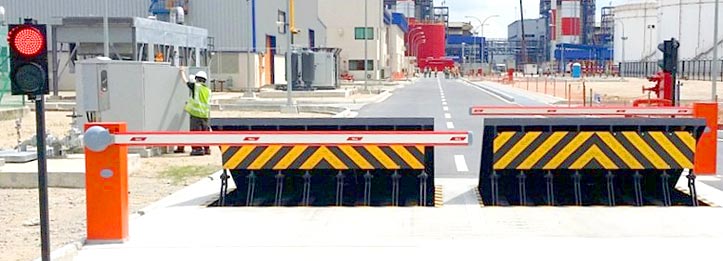Things about Wedge Barriers

Little Known Questions About Wedge Barriers.
The remaining pressure used to
the cam to deploy the wedge plate 16 may might provided given an electromechanical actuator 84 or other actuator. The springtime assembly 54 and the actuator 84(e. Wedge Barriers. g., electromechanical actuator)might operate with each other to equate the camera and raise the wedge plate 16.
As stated above, the spring assembly 54 puts in a consistent force on the webcam, while the electromechanical actuator might be regulated to apply a variable force on the webcam, consequently making it possible for the training and lowering( i. e., deploying and pulling back )of the wedge plate 16. In specific personifications, the consistent force used by the springtime setting up 54 might be flexible. g., electromechanical actuator) is impaired. As will certainly be valued, the springtime setting up 54 might be covered and protected from debris or other elements by a cover plate(e. g., cover plate 68 displayed in FIG. 4) that may be significantly flush with the elevated surface area 38 of the structure 14. As stated over, in the released position, the wedge plate 16 serves to block access or traveling beyond the obstacle 10. As an example, the obstacle 10(e. g., the wedge plate 16 )may obstruct pedestrians or vehicles from accessing a home or pathway. As gone over above, the barrier 10 is affixed to Recommended Site the support 30 safeguarded within the structure 14,

front brackets 71. Consequently, the affiliation settings up 72 might pivot and revolve to make it possible for the collapse and extension of the affiliation assemblies 72 during retraction and release of the bather 10. The affiliation assemblies 72 cause motion of the wedge plate 16 to be limited. If an automobile is taking a trip towards the deployed wedge plate 16(e. For example, in one condition, the safety and security legs 86 might be extended duringmaintenance of the barrier 10. When the safety legs 86 are deployed, the safety legs 86 support the weight of the wedge plate 16 versus the surface area 12. Consequently, the training device 50 might be shut down, serviced, eliminated, replaced, and so forth. FIG. 5 is partial perspective sight of a personification of the surface-mounted wedge-style obstacle 10, highlighting the camera 80 and the camera surface areas 82 of the lifting mechanism 50. Specifically, two cam surface areas 82, which are described as reduced camera surface areas 83, are placed listed below the cam 80. The lower cam surface areas 83 might be taken care of to the surface 12 (e. For example, Check Out Your URL the lower cam surface areas 83 and the placing plate 85 might develop a single item that is safeguarded to the support 30 by bolts or various other mechanical bolts. Additionally, 2 web cam surface areas 82, which are described as upper webcam surfaces 87, are positioned above the web cam 80 and combined to (e. In other personifications, interfering layers or plates might be positioned between the surface 12 and the reduced camera surface areas 83 and/or the wedge plate 16 and the upper cam surface areas 87 As pointed out above, the web cam
80 equates along the cam surface areas 82 when the wedge plate 16 is lifted from the retracted setting to the deployed placement. Furthermore, as discussed above, the springtime setting up 54 (see FIG. 3 )may offer a pressure acting upon the camera 80 in the direction 102 through spring pole 58, which may reduce the pressure the electromechanical actuator 84 is required to relate to the web cam 80 in order to activate and lift the wedge plate 16. 1 )to the released setting(see FIG. 4). As revealed, the camera 80 consists of track wheels 104(e. g., rollers), which get in touch with and translate along the camera surfaces 82 throughout operation.